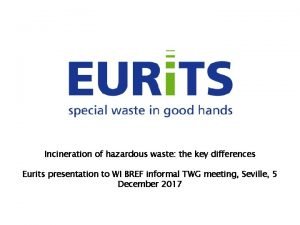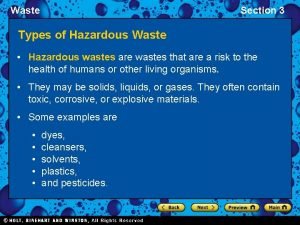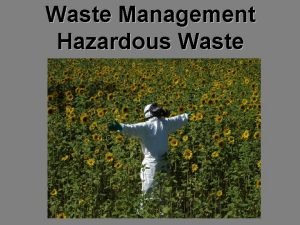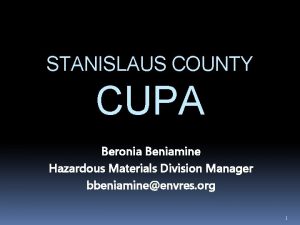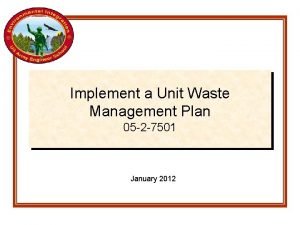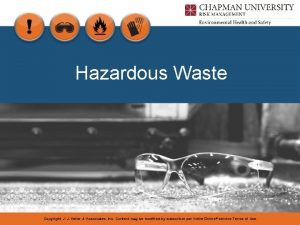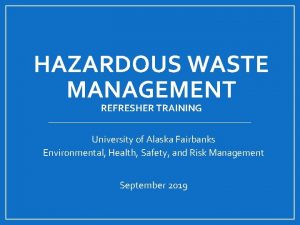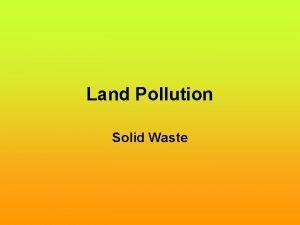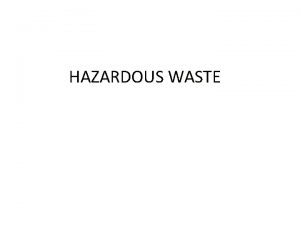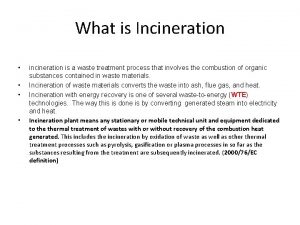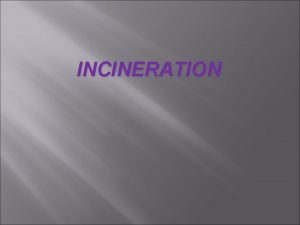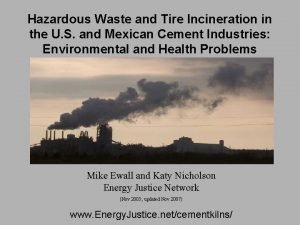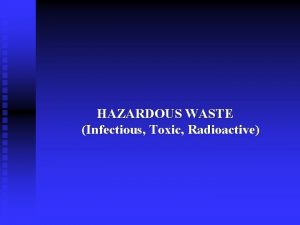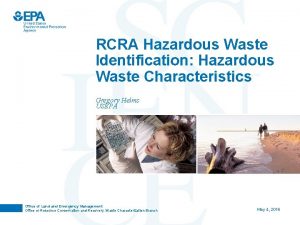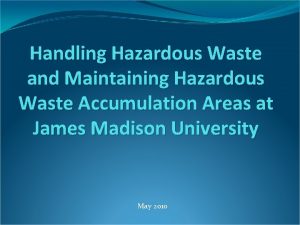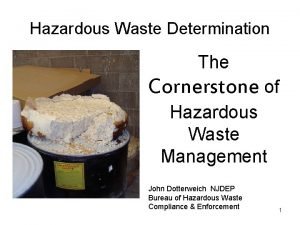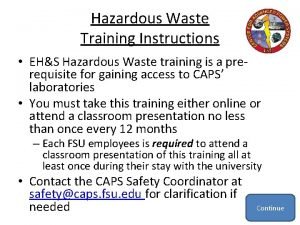Incineration of hazardous waste the key differences Eurits













- Slides: 13

Incineration of hazardous waste: the key differences Eurits presentation to WI BREF informal TWG meeting, Seville, 5 December 2017

What have we done? • Data & comments in conformity with Bref process • Information: • Eurits provided KUL study on a life cycle approach to emissions -> focus on integrated “IPPC” principle and cross-media impacts (Batis: 26. 03. 15) • Eurits provided 20 associated BAT proposals (Batis 15. 04. 16) • Site visits with focus on high temperature incineration (HTI): Eurits members Indaver (Hamburg, DE) & SARPI (Limay, F)

What do we experience? • Ko. M: possible mandate for specificity of HW: comments 75, 77 and 78 (no conflict with ideal of: “where possible BAT conclusions be identified for the whole of the WI sector” ie not always possible to generalise across whole WI sector) • Important BATs or parts of BATs relevant for HTI given in WI BREF 2006 disappeared without justification • Example BATs: 1, 4, 5, 8, 9, 10, 11, 19, 23, 26, 49, 56, 69, 70, 71, 72, 75 • Very little information provide by Eurits is referenced in D 1 revised BREF

10 codes of good practice for HTI 1. 3 major goals of HTI: destruction of organic persistent/ hazardous components; irreversible transformation of inorganic hazardous components; and energy/material recovery where possible 2. Guaranteed complete combustion is function of 5 operational parameters (5 Ts): temperature; (residence) time; turbulence; throughput; and type of waste -> see additional slide (BAT 19&49 2006) 3. Leads to a specific design - rotary kiln and post combustion chamber - to ensure similar conditions in gas and solid/liquid phase & guaranteed destruction in gas phase with no bypass of solids of the incineration point(s). (BAT 1, 23, 49&73, 2006) ->Alternative design: proof of similar performance and control i. e. equipment/expertise, emissions, burn out, DE and DRE 4. No derogations of minimum process conditions for HWI: 850 C and 2 seconds

10 codes of good practice 5. Specific infrastructure, e. g. storage, direct injection, safety, … to cope with hazards/risks of HW (BAT 5 2006) 6. Well trained, experienced & equipped staff (BAT 56 2006) 7. Analytical control of acceptance and process knowledge based on flow analysis -> known & traceable fate of hazardous components (BAT 4&69 2006) 8. Level of destruction of bottom ash is much more than just a TOC figure of 3% but also process operation eg slagging mode, visual inspection of unburned fraction, analysis of hazardous components… 9. Strict & adapted control of bottom ash from HWI quality if recovered e. g. PICs 10. Mixing of HW only for process optimization, not to lose traceability (BAT 11, 69 & 70 2006)

Purpose and priority For the incineration of hazardous waste main priorities: • Guarantee high levels of destruction efficiency for hazardous organic substances • Safe and reliable immobilisation of hazardous inorganic substances in flue gas cleaning residues Different emphasis to a waste-to-energy facility Size of plant, technology choices and operational strategy are different

Main characteristics of HTI An introduction Destruction efficiency Strict IED ELVs 3 T Burn-out SINK

The ‘ 3 T’ & ‘ 5 T’ principle Technology: static and rotary kiln, grate furnace & fluidised bed Temperature Technology Time Type of waste Combustion efficiency & Burn-out of BA Turbulence Throughput

Combustion performance • Detail on combustion performance largely missing in D 1 • TOC / LOI are a legal requirement but not the only or best indicator of burn out of HW, please consider: • Visual inspection of unburned or partially burned fractions • Additional analytical control if necessary i. e. presence of PICs, POPs…, • Process knowledge and control eg based on mass flow analysis • Tests for specific hazardous components if temperature is lower (ie 850 °C)

Combustion conditions • Process conditions are completely omitted from Chapter 5 • Post-combustion chamber for certainty of destruction of organic molecules • Strict minimum temperature of 850 °C for 2 seconds, increased to 1100 °C if Cl >1% • For incineration of HW derogations from minimum process conditions of 850 °C for 2 seconds should never be possible • Long term analysis of destruction efficiency (DE) and destruction removal efficiency (DRE) are potential tools to justify deviation from best practice

Process controls • Strict pre-acceptance and acceptance control • On site laboratory to analyse samples on arrival • Sampling regime tailored to risks of hazardous wastes • Well trained staff experienced in the task • Specialised storage e. g. tank farms; drum / IBC storage; bunker; small packages etc as appropriate • Dedicated waste preparation and waste feed systems e. g. direct injection

Types of waste • Waste is rarely homogenous, however municipal waste considerably more homogenous than hazardous waste. • The variability of the input differs much more significantly than municipal waste incinerators -> can never be captured in a questionnaire, only via ‘information’ • The types of waste will have a major impact on the type of plant that can incinerate a particular waste type (design of plant and necessary temperature), the throughput of particular waste types • Specialised waste handling from (pre-)acceptance to incineration including direct injection / shredders/ bulk tank storage etc

Possible solutions: the way forward? • Solution as agreed at Ko. M: separate section of chapter 5 for issues specific to HW • Or combination of footnotes and applicability to BATCs where incineration of HW is markedly different • Use the relevant BAT from existing WI BREF • BATC 15: many of our comments can be incorporated into BATC 15 The approach should address areas outlined in this presentation and comments on D 1 Outcome in terms of BAT AELs may be similar, but techniques to get you to BAT (and AELS) are very different! Thank you for your attention!
 Food waste management system
Food waste management system Eurits
Eurits Section 3 hazardous waste answers
Section 3 hazardous waste answers Hazardous waste neha
Hazardous waste neha Msw apes
Msw apes Example of hazardous waste
Example of hazardous waste Stanislaus county hazardous materials division
Stanislaus county hazardous materials division Waste management references
Waste management references Solid and hazardous waste
Solid and hazardous waste Keller hazardous waste disposal
Keller hazardous waste disposal Alaska hazmat training
Alaska hazmat training Cons of incineration
Cons of incineration Disadvantages of incineration
Disadvantages of incineration Key patners
Key patners

